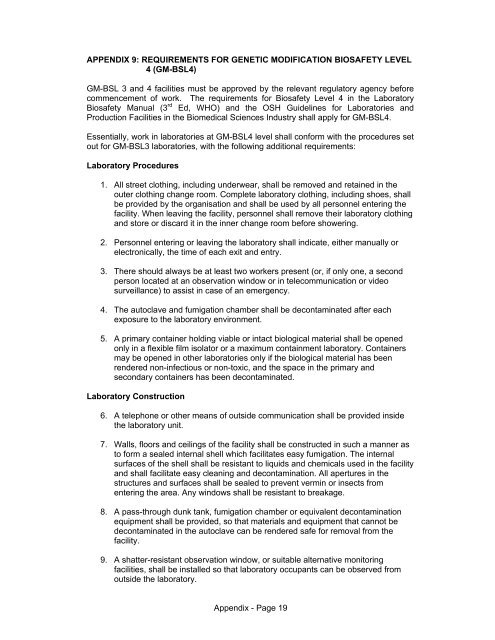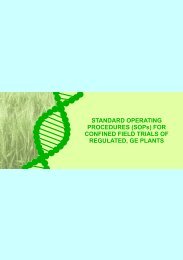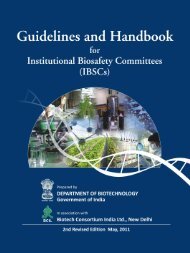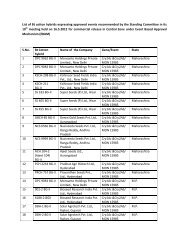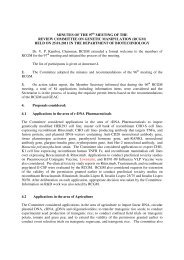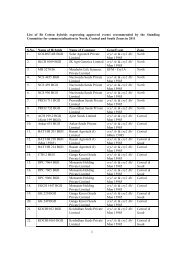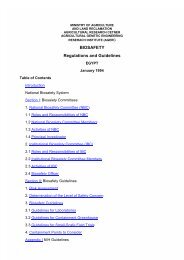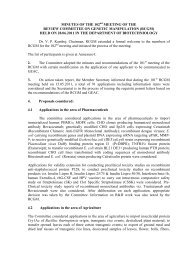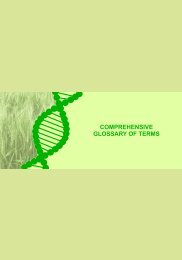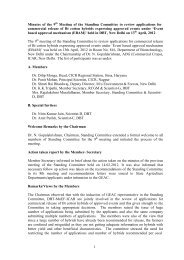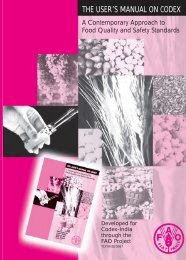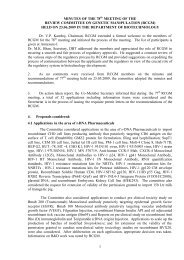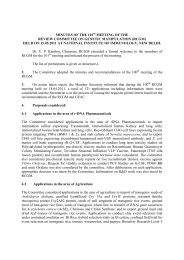Biosafety Guidelines For Research On Genetically Modified ...
Biosafety Guidelines For Research On Genetically Modified ...
Biosafety Guidelines For Research On Genetically Modified ...
You also want an ePaper? Increase the reach of your titles
YUMPU automatically turns print PDFs into web optimized ePapers that Google loves.
APPENDIX 9: REQUIREMENTS FOR GENETIC MODIFICATION BIOSAFETY LEVEL<br />
4 (GM-BSL4)<br />
GM-BSL 3 and 4 facilities must be approved by the relevant regulatory agency before<br />
commencement of work. The requirements for <strong>Biosafety</strong> Level 4 in the Laboratory<br />
<strong>Biosafety</strong> Manual (3 rd Ed, WHO) and the OSH <strong>Guidelines</strong> for Laboratories and<br />
Production Facilities in the Biomedical Sciences Industry shall apply for GM-BSL4.<br />
Essentially, work in laboratories at GM-BSL4 level shall conform with the procedures set<br />
out for GM-BSL3 laboratories, with the following additional requirements:<br />
Laboratory Procedures<br />
1. All street clothing, including underwear, shall be removed and retained in the<br />
outer clothing change room. Complete laboratory clothing, including shoes, shall<br />
be provided by the organisation and shall be used by all personnel entering the<br />
facility. When leaving the facility, personnel shall remove their laboratory clothing<br />
and store or discard it in the inner change room before showering.<br />
2. Personnel entering or leaving the laboratory shall indicate, either manually or<br />
electronically, the time of each exit and entry.<br />
3. There should always be at least two workers present (or, if only one, a second<br />
person located at an observation window or in telecommunication or video<br />
surveillance) to assist in case of an emergency.<br />
4. The autoclave and fumigation chamber shall be decontaminated after each<br />
exposure to the laboratory environment.<br />
5. A primary container holding viable or intact biological material shall be opened<br />
only in a flexible film isolator or a maximum containment laboratory. Containers<br />
may be opened in other laboratories only if the biological material has been<br />
rendered non-infectious or non-toxic, and the space in the primary and<br />
secondary containers has been decontaminated.<br />
Laboratory Construction<br />
6. A telephone or other means of outside communication shall be provided inside<br />
the laboratory unit.<br />
7. Walls, floors and ceilings of the facility shall be constructed in such a manner as<br />
to form a sealed internal shell which facilitates easy fumigation. The internal<br />
surfaces of the shell shall be resistant to liquids and chemicals used in the facility<br />
and shall facilitate easy cleaning and decontamination. All apertures in the<br />
structures and surfaces shall be sealed to prevent vermin or insects from<br />
entering the area. Any windows shall be resistant to breakage.<br />
8. A pass-through dunk tank, fumigation chamber or equivalent decontamination<br />
equipment shall be provided, so that materials and equipment that cannot be<br />
decontaminated in the autoclave can be rendered safe for removal from the<br />
facility.<br />
9. A shatter-resistant observation window, or suitable alternative monitoring<br />
facilities, shall be installed so that laboratory occupants can be observed from<br />
outside the laboratory.<br />
Appendix - Page 19


